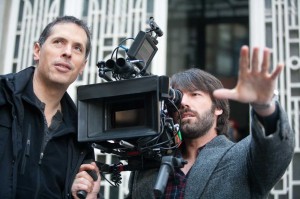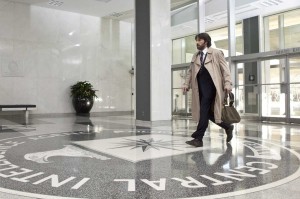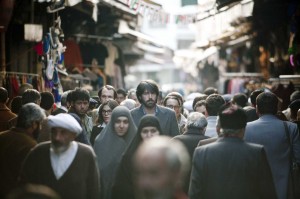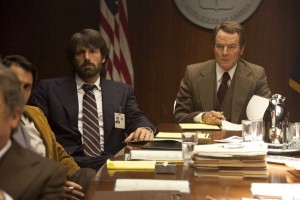
To photograph Argo, cinematographer Rodrigo Prieto employed an assortment of cameras, shooting styles and film stocks to visually recreate the true story of a little-known covert rescue operation that the CIA pulled off in Tehran during the Iran hostage crisis in 1979.
Directed by Ben Affleck who also stars in the film, the three main settings in the nail-biting suspense – larded with episodes of delicious hilarity – include Tehran, CIA headquarters outside of Washington, DC and Hollywood where “Argo,” a faux film project is concocted to shoot in the Iranian capital. The filming would serve as a front for a daring rescue of six American embassy workers who have managed to hide out in the Canadian ambassador’s residence.
But the nine-week shoot did not take place in Tehran, for obvious reasons. Locations in Los Angeles and Istanbul became convincing proxies for Iran’s capital. The basement of the Los Angeles Times was used to recreate the spy agency’s offices (with one brief visit to film in the lobby of the real CIA, an opportunity rarely granted to filmmakers). And the studio scenes were conveniently shot on Hollywood sets and surrounding locations.

Prieto’s task was to stitch and blend all the pieces together seamlessly while also creating a recognizable frame of reference for each setting. “We wanted to have a cohesive movie visually, even if shots were done in different parts of the world,” he noted. At the same time each setting was made to look distinctive. “The objective was to help the audience instantly identify where they are as soon as the images change on the screen,” said the DP.
The tumultuous opening where the mob breaks through the walls and into the American Embassy was shot documentary style on a soccer field outside Istanbul. “I wanted the frenetic feel of a handheld camera being in the midst of it all,” he said. He used 2-perf super 35 mm while zooming in to resemble news footage. “That made it much grainier, closer to 16 mm, but it also had the sharpness and definition of 35.” In addition, a few camera operators, dressed as extras, shot with lightweight Bolex cameras from within the crowd.

The scenes lensed in and around L.A. included the interior of the Canadian Ambassador’s residence, which was filmed in a house in Hancock Park. Prieto shot with a restrained handheld style, shifting attention between the Americans as they interacted in the cramped quarters.
The office scenes at the CIA, where bureaucrats ponder the merits of the seemingly wacky plan, were shot using an anamorphic lens. Windows that matched the shape of those at Langley were inserted into rooms in the Times’ basement and lit from behind. “I wanted a clean controlled feel so we didn’t shoot anything handheld, we were mostly on dolly and also used Steadicam to give a feeling of urgency.”
For the Hollywood scenes where the plan for making the bogus film shoot gets hatched, Prieto went for a more color-saturated, circa 1979, look. He also had some fun. “I put in a lot of zooms – zooms from helicopters, zooms from cars – which was a technique you saw a lot in the ’70s,” he said.

The DP, born in Mexico City, says his favorite scene took place in Istanbul, in the main bazaar, similar to the one in Tehran, when the Americans attempting to escape pretend to be members of the Argo film crew. “It was tricky to shoot, but at the same time quite exhilarating,” he recalled. The bazaar was closed for the day, (it was fortuitously also a holiday), and packed with extras playing merchants and shoppers. “We turned down all the lights they had. We wanted a scary dark atmosphere, and only did the lighting that was required.” Theatrical lights created pools of sunlight. “When the tension rises, it’s dark around the embassy workers but they are in the spotlight,” he noted.
One eye-catching scene was filmed within Hagia Sophia, the historic mosque in Istanbul, where Affleck’s spymaster character Tony Mendez meets with a British intelligence counterpart. A large space to be used for the shoot was lit by dozens of circular chandeliers, but the original light bulbs had been converted to compact fluorescents which were too harsh, and also were not there in 1979. Members of the crew worked overnight to switch out the more than 4,000 bulbs, producing softer light. After the shoot, the Mosque kept the replacements.
Prieto called his experience working with Affleck “a great collaboration.” He was impressed how he choreographed actors for the camera. In his dual role “Ben would come in early every day, go to makeup first, then arrive on the set to talk about that day’s shoot, finish up the lighting with me, then get in front of the cameras,” said the cinematographer.
The DP was nominated for a best cinematography Oscar in 2006 for his work on Brokeback Mountain for director Ang Lee. He first rose to prominence working with Mexican director Alejandro González Iñárritu on Amores Peros and 21 and encored with him on Biutiful. Other credits include Frida, directed by Julie Taymor, and Oliver Stone’s Alexander and Wall Street: Money Never Sleeps. He is currently filming The Wolf of Wall Street for Martin Scorsese.





